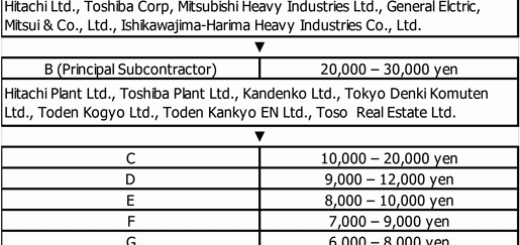Management of cosmic ray exposure to aircraft crew Nuke Info Tokyo No. 109
On November 1st, the Ministry of Education, Culture, Sports, Science and Technology compiled a report entitled “Investigation into Cosmic Ray Exposure to Aircraft Crew (tentative title)”. The purpose of this report was to reveal the situation of cosmic ray exposure to aircraft crew and develop a basic approach to the issue.
Last June, an investigative working group was formed within the Radiation Safety Regulations Investigative Committee (our translation), made up of experts in the fields of radiological protection, cosmic ray research, and radiation measurement. Explanations were provided by the Japan Aerospace Exploration Agency, the Japan Health Physics Society, the International Commission on Radiological Protection (ICRP), and representatives from foreign industries. Opinions on the situation of aircraft crew were heard from the Scheduled Airlines Association of Japan (SAAJ) and the Airline Pilots’ Association of Japan.
Aircraft crew persons frequently work on aircraft which fly at high altitudes and high latitudes, making their radiation exposure from cosmic rays far greater than that of the average person. ICRC 1990 Yearly Report called for treating cosmic ray exposure of aircraft crew as occupational exposure. According to ICRP Publication 75, the dosage rate from cosmic rays at an altitude of 8,000m is approximately 3 micro-Sievert/hour and at an altitude of 12,000m it is approximately 5 micro-Sv/hr. In that case, if a person works for 200 hours a year on a jet which flies at an altitude of 12,000m, his or her radiation exposure to cosmic rays would total approximately 1 milli-Sv. Working regulations for Japanese domestic enterprises are set which limit maximum yearly working hours to 900-960 hours. Thus, actual yearly radiation exposure would be approximately 5 milli-Sv. This is approximately five times the yearly external radiation exposure to members of the general population. According to SAAJ, the average length of employment for domestic aircraft crew is 10-13 years. When coupled with the fact that radiation exposure would increase even further if large-scale solar flares were encountered during flights, it is estimated that the lifetime radiation exposure of aircraft crew is much higher, even when compared to that of the average nuclear power plant worker, or worker in other fields related to radiation. However, cosmic ray radiation exposure of aircraft crew has yet to be designated as occupational exposure in Japan.
Although this report concluded that there is no need to regulate cosmic ray exposure of aircraft crew by law, it did call for enterprises to voluntarily manage the exposure dosage of crew and to conduct educational activities related to cosmic ray radiation exposure. Specifically, it suggested that the following measures were appropriate:
- Enterprises should calculate each crew person’s exposure dosage and enable each person to freely view his or her exposure status;
- Results should be recorded and preserved;
- Topics on cosmic ray exposure should be included in educational programs at the workplace;
- In particular, women crew persons should be informed of the effects of radiation on a fetus;
- Health education and health consultations by medical doctors from the industry should be conducted.
Further, regarding the health management of aircraft crew, the report stated that medical checks currently being conducted were sufficient and that there was no need for new medical checks. Regarding damage to health thought to be caused by exposure to cosmic rays, such as cancer, the report concluded that sex, age, socioeconomic conditions, and lifestyles were major factors, and did not go as far as to clearly acknowledge the effects of cosmic rays.
However, a mere approximate calculation of radiation exposure, or management of flight duties cannot address the problems of suddenly occurring large-scale solar flares, nor the radiation exposure to the embryo of a woman crew person in the early and undetected stages of pregnancy. While it is not possible to manage perfectly radiation exposure from cosmic rays, or to avoid all risk completely, it is important to develop more concrete guidelines to lessen unnecessary exposure.
Further, this investigation covered aircraft crew only and did not include debate on persons who frequently use aircraft for work (such as tour conductors, etc.). It is necessary to make sure that in the future the radiation exposure of such persons can also be managed.
Ikuko Kuwabara (CNIC)

